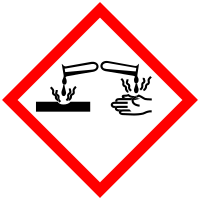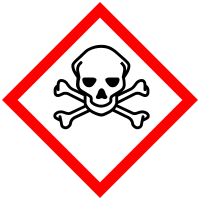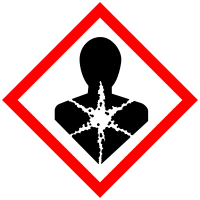
Improving Member States preparedness to face an HNS pollution of the Marine System (HNS-MS)
Benzyl Chloride
Description Top
| CAS number | 100-44-7 |
| UN number | 1738 |
| Chemical formula | C7H7Cl |
| Standard European Behaviour Classification (SEBC) | Sinker (S) |
GESAMP Hazard profile
| A1 | A2 | B1 | B2 | C1 | C2 | C3 | D1 | D2 | D3 | E1 | E2 | E3 |
| 1 | R | 3 | 1 | 1 | 2 | 3 | 3 | 3 | CSsA | NI | S | 3 |
Marine pollution Classification (MARPOL Annex II)
| Category | Description |
| Y | Noxious Liquid Substances which, if discharged into the sea from tank cleaning or deballasting operations, are deemed to present a hazard to either marine resources or human health or cause harm to amenities or other legitimate uses of the sea and therefore justify a limitation on the quality and quantity of the discharge into the marine environment. |
Alternate names for this chemical
Chloromethyl Benzene
Alpha-Chlorotoluene
Benzyl Chloride
Chlorure De Benzyle
α-Chlorotoluene
Alpha-Chlorotoluene
Benzyl Chloride
Chlorure De Benzyle
α-Chlorotoluene
Physico-chemical properties Top
| Chemical formula | C7H7Cl | ||
| Molar mass | 126.584 [g/mol] | ||
| State | Liquid at 25°C and 1 atm | ||
| Fusion temperature | -45 [°C] | ||
| Boiling temperature | 179 [°C] | ||
| Critical temperature | 411 [°C] | ||
| Density |
|
||
| Surface tension |
|
||
| Hydrosolubility |
|
||
| Vapour pressure |
|
||
| Vapour density | 4.36 | ||
| Flash point (Pensky-Martens closed cup) | 67 [°C] | ||
| Flash point (Cleveland open cup) | 74 [°C] | ||
| Lower explosivity limit (LEL) | 1.1 [%] | ||
| Upper explosivity limit (UEL) | 7.1 [%] | ||
| Vaporization enthalpy |
|
||
| Combustion enthalpy | 29292802 [J/Kg] | ||
| Specific heat capacity | 1440 [J/(Kg·K)] | ||
| Henry's constant | 41.54 [mol/(m³·Pa)] |
Behaviour Top
| Log Kow | 0.36 |
| Log Koc | 2.65 |
| Standard European Behaviour Classification (SEBC) | Sinker (S) |
Ecotoxicity Top
| Lowest median lethal concentration (LC50) on algae | 19.3 [mg/l] | ||
| Lowest median lethal concentration (LC50) on crustacean | 3.9 [mg/l] | ||
| Lowest median lethal concentration (LC50) on fishes | 6 [mg/l] | ||
| Highest no observed effect concentration (NOEC) on algae | 10 [mg/l] | ||
| Assessment factor (AF) |
|
||
| Predicted No Effect Concentration (PNEC) |
|
Hazards Top



Danger
Hazards statements
Health
H302
Harmful if swallowed.
H315
Causes skin irritation.
H317
May cause an allergic skin reaction.
H318
Causes serious eye damage.
H331
Toxic if inhaled.
H335
May cause respiratory irritation.
H350
May cause cancer.
H373
May cause damage to organs through prolonged or repeated exposure, exposure cause the hazard:
GESAMP Top
GESAMP Hazard profile
| A1 | A2 | B1 | B2 | C1 | C2 | C3 | D1 | D2 | D3 | E1 | E2 | E3 |
| 1 | R | 3 | 1 | 1 | 2 | 3 | 3 | 3 | CSsA | NI | S | 3 |
A1: Bioaccumulation
| Rating | Description |
| 1 | Very low potential to bioaccumulate |
A1a:
| Rating | Description |
| NI | No Information |
A1b:
| Rating | Description | Criteria |
| 1 | Very low potential to bioaccumulate | 1 ≤ BCF < 10 |
A2: Biodegradation
| Rating | Description |
| R | Readily biodegradable |
B1: Acute aquatic toxicity
| Rating | Description | Criteria [mg/l] |
| 3 | Moderately toxic | 1 < LC/EC/IC50 ≤ 10 |
B2: Chronic aquatic toxicity
| Rating | Description | Criteria [mg/l] |
| 1 | Low | 0.1 < NOEC ≤ 1 |
C1: Acute oral toxicity
| Rating | Description | Criteria [mg/Kg] |
| 1 | Slight | 300 < AOTE ≤ 2000 |
C2: Acute dermal toxicity (skin contact)
| Rating | Description | Criteria [mg/Kg] |
| 2 | Moderate | 200 < ADTE ≤ 1000 |
C3: Acute inhalation toxicity
| Rating | Description | Criteria [mg/l] (4 hours exposure) |
| 3 | Moderately high | 0.5 < AITE ≤ 2 |
D1: Skin irritation or corrosion
| Rating | Description | Sign | GHS category |
| 3 | Severely irritating or corrosive | Severe irritation indi | Corrosive Category 1 |
D2: Eye irritation
| Rating | Description | Sign | GHS category |
| 3 | Severely irritating or corrosive | Severe conjunctoblepha | Irritant Category 1 |
D3: Long-term health effects
| Notation | Hazard endpoint | Description | GHS category |
| C | Carcinogenicity | Chemicals which have been shown to induce or increase the incidence of cancer | Category 1 for Carcinogens |
| Ss | Skin Sensitization | Cause specific skin hypersensitivity or allergy following skin contact | Category 1 for Skin Sensitizers |
| A | Aspiration | Lung injury or chemical pneumonia following aspiration of a chemical through the oral or nasal cavity into the trachea or lower respiratory system | Category 1 for Aspiration Toxicity |
E1: Tainting of seafood
| Rating | Description |
| NI | No Information |
E2: Behaviour of chemicals in the marine environment
| Rating | Description |
| S | Sinker |
E3: Interference with the use of coastal amenities
| Rating | Interference | Description | Interpretation | Warning |
| 3 | Highly objectionable | 1 is highly acutely toxic; and/or 2 is severely irritant or corrosive to skin or eyes; and/or 3 is carcinogenic, mutagenic or reprotoxic; and/or 4 is a floater or persistent floater with associated health effects | 1 C1 and/or C2 and/or C3 = 4; and/or 2 D1 or D2 = 3, 3A, 3B, or 3C; and/or 3 D3 contains C, M or R; and/or 4 E2 = F or Fp and D3 contains Ss, Sr, T, A, N, or I | Warning issued leading to the closure of amenities |
GHS Security Information



Danger
About the project
HNS-MS is a decision-support tool that Belgian and French maritime authorities as well as coastguard stations can activate in order to forecast the drift, fate and behavior of acute marine pollution by Harmful Noxious Substances (HNS) accidentally released in the marine system.
Contact us
Copyright © 2015–2026 HNS-MS Consortium
 HNS-MS has been funded by DG-ECHO under agreement ECHO/SUB/2014/693705 and runs from 1 January 2015 to 31 March 2017.
HNS-MS has been funded by DG-ECHO under agreement ECHO/SUB/2014/693705 and runs from 1 January 2015 to 31 March 2017.